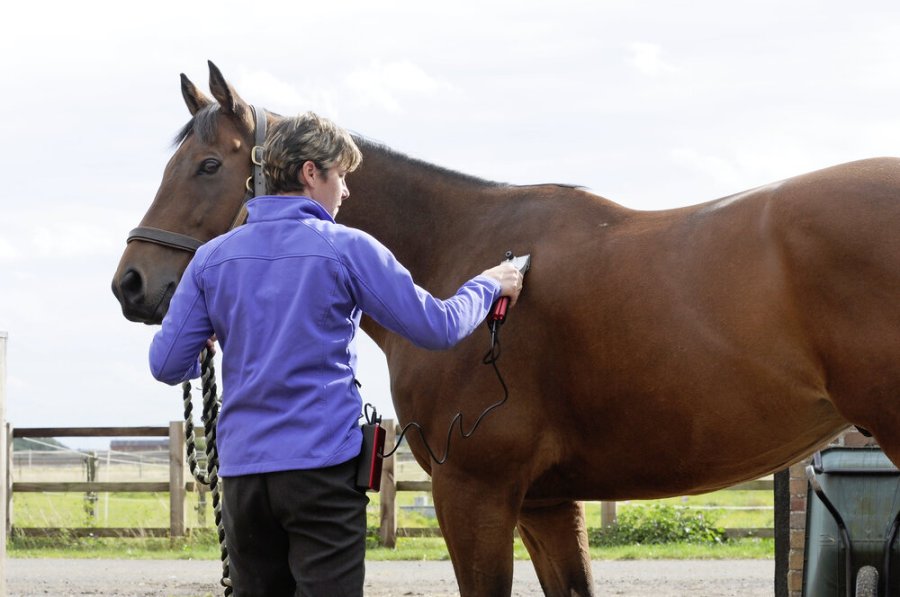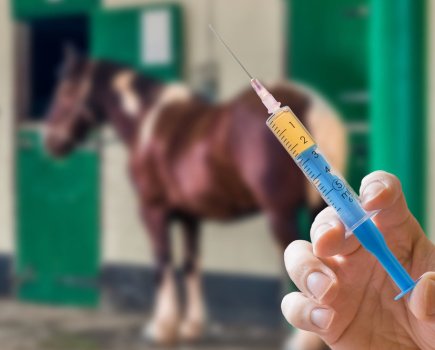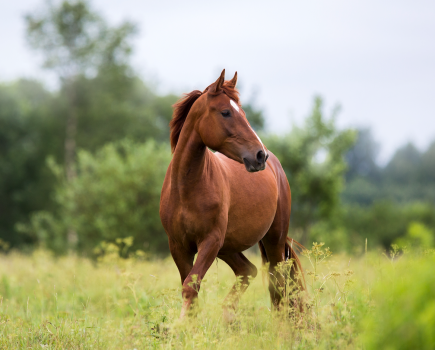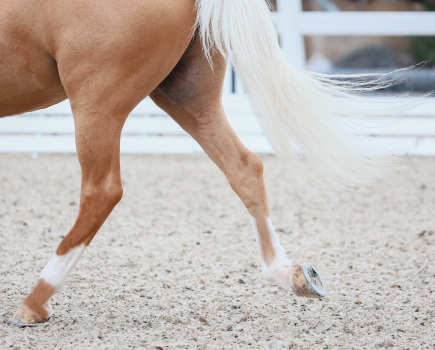Before you start clipping your horse, think carefully about how much hair you need to remove. Take your horse’s workload, lifestyle and age into consideration – can you keep him well-rugged and warm enough if you clip out his body completely, or would a partial trim where he sweats most frequently be sufficient?
Clipping is a key job when taking care of a horse in winter, so it’s important to get it right. As a general rule, horses continuing to do a lot of work during the cold months who are stabled at night suit having more hair removed than a horse in lighter work or one who will be turned out at night. Find out more which type of clip would suit your horse best below.
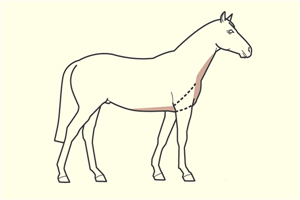
Type of clip: neck and belly clip
Type of horse clip: neck and belly (bib) clip
A bib clip is an underside trim which is ideal for any horses in light work who are turned out all through the winter. This is a popular clip because it is simple to do. Any mistakes or uneven lines aren’t obvious and it still leaves your horse with plenty of coat on their body.
This clip is also called the ‘sweat clip’ as it takes off hair only where the horse sweats most. You can also remove hair over the tops of the front legs.
How to do a neck and belly (bib) clip:
- Chalk your guidelines. For the belly, take a line from the elbows, horizontally back to the stifles.
- Clip as for a bib clip, or an apron clip if you’re taking off the hair over the forelegs too.
- Move to the belly. If the horse is wary, stroke along it with your hand in long, firm strokes first.
- Don’t be too light with your clippers as it tickles the horse more.
How to clip over and inside the elbow:
- Have a helper pull the horse’s foreleg forwards to make the area you’re clipping flatter and firmer. Pull any loose skin taut so that you don’t nick it with the clipper blades.
- Follow the horse’s muscle that runs diagonally along the top of the foreleg to get a neat angle.
Remember, a horse’s winter coat provides protection from the elements, so if you clip any hair, rug up accordingly to keep them warm – especially if they are spending time in the field. Remember, too, that the horse will be pretty fresh to ride on a frosty morning if you remove all their winter woollies, because they’re cold!
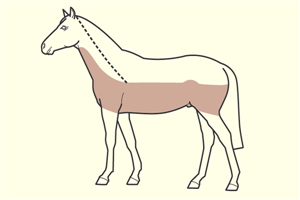
Type of clip: trace clip
Type of horse clip: trace clip (low or high)
A trace clip is suitable for a horse in light or medium work. A higher trace can include the whole or part of the head, which is also called a chaser clip (see dotted line on diagram, right).
Named after the traces of a carriage, the trace clip follows straight horizontal lines along the horse’s body and demands accuracy.
Trace clips can be low, medium or high. A high trace clip also takes off hair from the horse’s head. High trace clips give the illusion of making the legs appear longer on a short-legged horse.
How to do a trace clip:
- For a low trace clip, take a line around 7in below where your saddle flap lies; for a medium clip, use the bottom of the saddle flap as a guide; for a high trace clip, take a line about 5in above the bottom of the saddle flap.
- Make your chalk lines clear, straight and symmetrical on each side, especially over the backs of the hindquarters.
- To neaten a horizontal line, turn the clippers side-on so the blades cut neatly across the jagged edge.
- For a chaser clip, take a line from behind the horse’s shoulder up to behind his ears. Take off more neck hair and all the head hair.
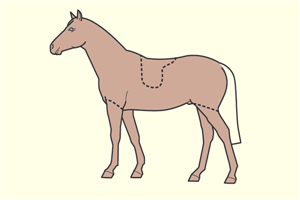
Type of clip: hunter clip
Type of horse clip: hunter clip
A hunter clip is suitable for a horse in medium to hard work. The legs and saddle area are left on for protection (see dotted lines on diagram, right). For a full clip, these can be removed completely.
The hunter clip is a variation of the full clip, but with leg and saddle patch hair. It’s good for horses who work hard but are likely to pick up thorns, knocks and cuts out hacking or hunting. Leaving the hair over the saddle patch helps keep sweat away from the skin.
For a full clip, the whole coat is taken off. It can be used as a first clip and swapped for a different one later in the year. Great care must be taken to keep horses with a full clip warm, especially at night.
How to do a hunter clip:
- For a hunter clip, mark neat diagonal guidelines on the tops of the horse’s front and hind legs. Place their saddle on and draw an outline around it, with a 2in margin all around. Clip all other hair apart from the legs and saddle patch.
- For a full clip, take off all hair, including legs and face.
- When clipping the inside of the hind legs, move the tail out of the way and clip from the opposite side. It’s easier to plait the tail and tie it up to keep it out of your way.
- Leave a neat ‘v’ of unclipped hair above the root of your horse’s tail. It will look like an upside down ‘v’ when you stand behind the horse with the point of the v pointing towards where your saddle sits. Take a point about 6in from each side of his tail and take a line up to his spine.
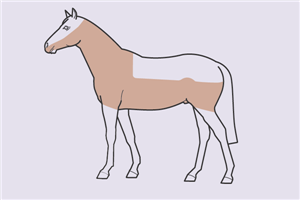
Type of clip: blanket clip
Type of horse clip: blanket clip
A blanket clip leaves a blanket of long coat covering the horse’s back to provide warmth and protection from the weather, while removing enough hair from the rest of the horse’s body to ensure efficient cooling during and after hard exercise.
A ‘blanket’ of hair is left over the horse from wither to tail and on the legs. This type of horse clip is good for horses in medium to hard work. You’ll need to provide warm rugs with a neck cover if you use this clip and want to turn your horse out in winter. Blanket clips give the impression of your horse’s back being shorter, so can flatter a long-backed horse.
How to do a blanket clip:
- Be guided by your saddle: the front edge of your blanket should sit just in front of the saddle, and the bottom edge in line with your saddle flaps (you can come a little higher if you like).
- Take off the hair from the horse’s neck, chest, head, belly, and the tops of their hind legs, taking care to go over straight lines with the edge of your clippers. This clip needs to be neat with even lines.
- To achieve an even blanket clip on both sides, stand several feet in front of your horse so that you can see where the line runs on both sides. Do the same standing several feet behind the horse to check the lines from this perspective too. But be careful and don’t get kicked.
- All neck hair needs to be removed. To do this, brush the mane over to the other side and clip up to 1cm below the roots of their mane. Repeat this on the other side. Don’t clip too high or you’ll clip into the mane, which will result in messy regrowth.
You might also be interested to read our expert advice for how to clip a horse and tips for clipping a horse who is scared of clippers or who you are clipping for the first time.
Love hacking? Join our free #Hack1000Miles challenge and see how far you can go!

